According to the different composition and metallogenic conditions of lead-zinc ore, the equipment used in the beneficiation process is also different. However, the technological process is basically the same, which is divided into several stages including: crushing, grinding, classifying and dehydration. Next, let's learn about the commonly used process equipment for lead-zinc beneficiation through various stages of operation.
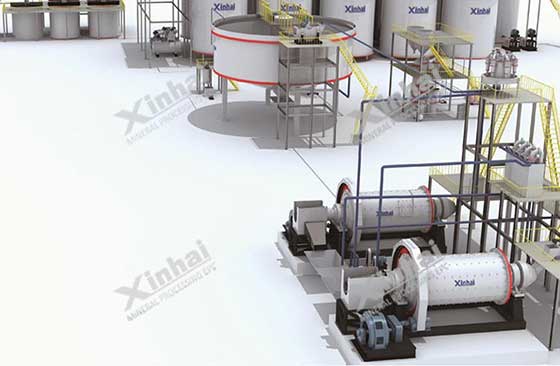
Use the table of contents below to navigate through the guide:
01Lead-zinc ore crushing equipment
The crushing stage of lead-zinc ore can generally be divided into two parts: crushing and screening. Its main purpose is to crush the lead-zinc ore of large blocks to a certain extent, so as to realize the preliminary dissociation between minerals. Two-stage closed-circuit crushing process is mostly used in this stage. The raw ore is fed into the first-stage crusher by the miner for coarse crushing. The crushed product is sent to a circular vibrating screen for screening by No. 1 belt conveyor. The material on the screen is unqualified material, which needs to be sent to the second-stage crusher through the No. 2 belt conveyor for further crushing. During transportation, electromagnetic iron separators and metal detection equipment will be set up to remove magnetic impurities in minerals in advance. The undersize will be sent to the fine ore bin for storage by the No. 3 conveyor, ready for subsequent grinding operations.
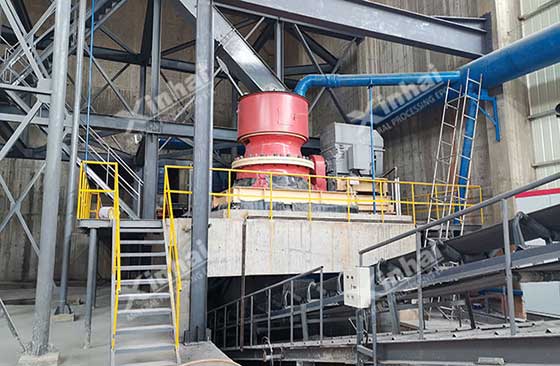
The main process equipment used in this stage are: feeder, jaw crusher, cone crusher, circular vibrating screen and belt conveyor.
Feeder: According to the process design, there are several choices of trough feeder, electromagnetic vibration feeder and pendulum feeder.
Jaw crusher: used for a coarse crushing operation.
Cone crusher: used for secondary or fine crushing operations.
Circular vibrating screen: According to the different sieving particle size, single-layer screen or double-layer screen can be selected.
Electromagnetic iron remover: remove iron-containing impurities in lead-zinc ore in advance;
Metal detector: used to detect ferrous impurities in the conveyor belt.
Belt conveyor: The loose density of conveyable materials should be 2.5t/m3.
02Lead-zinc ore grinding equipment
The grinding stage can be divided into two parts: grinding and grading. The main purpose is to further realize the monomer dissociation of the crushed minerals in order to meet the optional requirements. Depending on the nature of the minerals, the selected process for grinding is also different. There are one-stage grinding process and multi-stage grinding process (including tailings regrinding and concentrate regrinding).
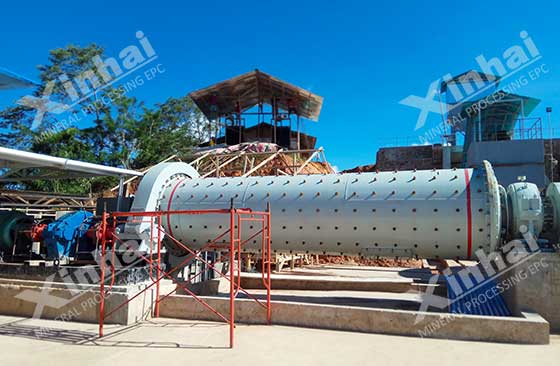
When there is an uncomplicated symbiotic relationship between lead-zinc ore and gangue minerals, and the coarse-grained and unevenly embedded minerals are disseminated in particle size, a grinding process can be selected. For lead-zinc sulfide ore, if there is a complex symbiotic relationship between useful minerals and gangue minerals or when useful minerals cannot be embedded, a multi-stage grinding process (usually two-stage grinding process) should be selected. This process can fully dissociate the useful minerals embedded in coarse grains.
Taking the two-stage regrinding process as an example, the process is as follows: the crushed ore is sent by the belt conveyor to the first-stage ball mill for grinding. After grinding, the material enters the linear vibrating screen for desliming. The material on the sieve is returned to a ball mill for regrinding. The undersize is pumped to a hydrocyclone for classification. The underflow is returned to the first-stage ball mill for regrinding, and the overflow is sent to the second-stage ball mill for grinding. The classification also adopts hydrocyclone (spiral classifier can also be selected according to beneficiation conditions) classification. The underflow returns to the second-stage ball mill for regrinding, and the overflow enters the sorting stage.
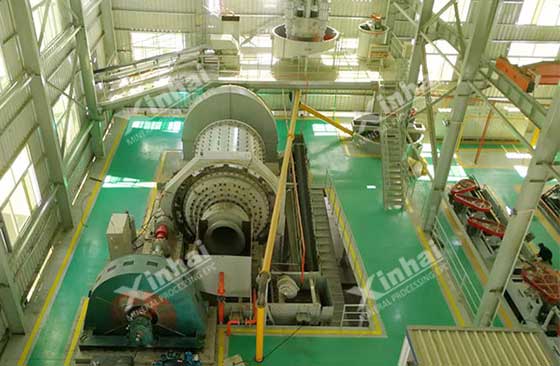
The main process equipment used in this stage are: grid ball mill, overflow ball mill, hydrocyclone group, linear vibrating screen and slurry pump.
Lattice-type ball mill: commonly used in one-stage grinding operation for rough grinding, grinding to -0.074mm60.00%~65.00%.
Overflow ball mill: used for fine grinding in the second-stage grinding operation, grinding to -0.074mm85% or more.
Hydrocyclone unit: It is mostly used in conjunction with overflow ball mill for fine particle classification.
Linear vibrating screen: the main purpose is to de-sludge, and send 20-200 mesh fine-grained materials to the linear vibrating screen to separate out the sediment;
Slurry pump: used to transport slurry materials.
03Lead-zinc ore beneficiation equipment
The separation process of lead-zinc ore is mainly to separate the useful ore from the gangue ore in the minerals to obtain useful minerals, and then realize the separation. In the beneficiation method of lead-zinc ore, flotation is the main method, and two kinds of direct preferential flotation and mixed flotation are commonly used. Among them, the direct preferential flotation is a method of selecting the other in sequence according to the floatability characteristics of minerals. Mixed flotation is to flotate the useful minerals together first, and then separate the useful minerals to obtain a single concentrate, such as copper concentrate, lead concentrate and zinc concentrate.
Taking mixed flotation as an example, to deal with the lean ore in which the useful minerals are aggregates, the process of one coarsening, multiple refining and multiple sweeping is mostly used. After grinding and classification, the product is sent to the stirring tank for stirring to ensure that the slurry is fully mixed and then sent to the flotation machine for sorting. First, roughing is carried out to obtain lead and zinc mixed ore, and then lead and zinc beneficiation operations are carried out in turn.
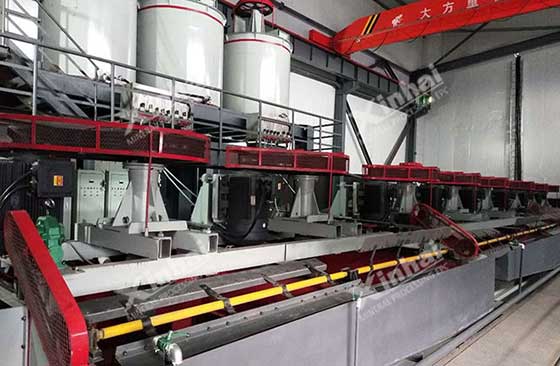
Lead selection: Two selection processes are adopted. In the first selection, ZnSO4, lime, terpineol, and ethyl thiazide are added; in the second selection, sodium sulfite, zinc sulfate, black medicine and ethyl thiazide are added.
Zinc selection: the same two selection processes are used. Lime, xanthate and terpineol are added in the first selection, and no chemicals are added in the second selection.
The main equipment used in this stage are: XCF flotation machine, KYF flotation machine, SF flotation machine, JJF flotation machine, chemical stirring tank, high-efficiency stirring tank.
XCF/KYF flotation machine: The two flotation machines can be used alone or in several groups, and are used for roughing and sweeping operations in lead and zinc concentrators;
SF/JJF flotation machine: The two machines can also be used alone or in combination. They are generally used for selection and sweeping operations in lead-zinc ore dressing plants.
Pharmacy stirring tank: When using mixed medicaments, it is necessary to use the pharmacy stirring tank to fully stir the different medicaments;
High-efficiency stirring tank: The high-efficiency stirring tank is used for mixing medicine and pulp.
04Lead-zinc mine dehydration equipment
The lead and zinc concentrates and tailings after separation are in the wet state and need to be dehydrated. The concentrate is used for processing, and the tailings are piled into tailings ponds. Among them, the dehydration process of lead and zinc concentrates often adopts the dehydration method of concentrator + filter press. The obtained lead and zinc concentrate slurries are pumped into their respective thickeners by slurry pumps for dehydration, so that the water content is lower than 60%. Then, they are respectively stored in the pump box for storage, and then pumped into the filter press respectively by the pump for dehydration, so that the water content of lead concentrate and zinc concentrate is lower than 20%. The dehydration of lead-zinc mine tailings depends on the requirements of tailings treatment, and different tailings dry discharge processes can be used.
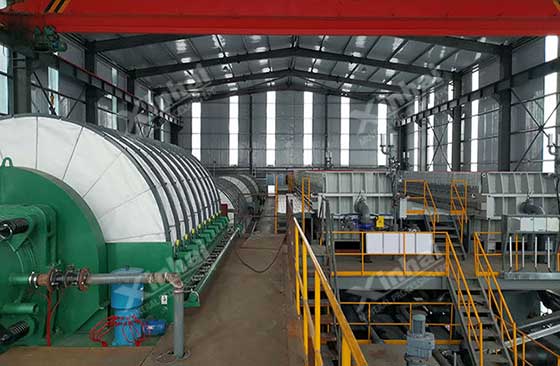
The main equipment used in this stage are: high-efficiency thickener, chamber filter press, vacuum filter, dewatering screen and cyclone.
High-efficiency thickener: suitable for dehydration of concentrate/tailings, one more stage of dehydration in the concentrate, and two stages of dehydration in the tailings, the low flow concentration is 60~70%.
Chamber filter press/vacuum filter: It can be used for dewatering of fine/tailings, and it is mostly used in the final stage, and the moisture content of the pulp is lower than 9~12%. High-frequency dewatering screen: It is mostly used for tailings dewatering, and is used for three-stage dewatering operations, so that the final moisture content of tailings is 12-15%.
Hydrocyclone: It is used in the first stage of dehydration in tailings dehydration, and the low-flow water content is 40-30%.
The above mainly introduces the equipment commonly used in the conventional lead-zinc ore beneficiation process. It is suggested that before beneficiation, the beneficiation test and analysis should be carried out, and the technological process and complete sets of equipmentshould be customized scientifically and reasonably.


 marketing@ytxinhai.com
marketing@ytxinhai.com  0086 13810327080
0086 13810327080 






































































































 CHAT
CHAT MESSAGE
MESSAGE








